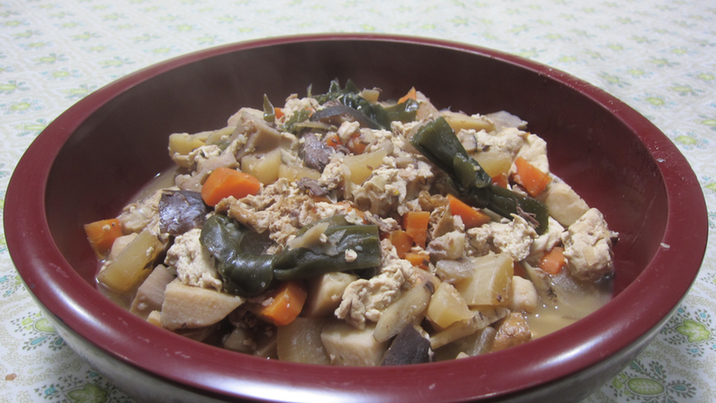
Alright, let’s talk about a real Hiroshima classic – “Hassun”! This is a hearty and flavorful dish that’s been a staple in areas with a strong tradition of Aki-Monto (followers of the Jodo Shinshu sect of Buddhism in western Hiroshima). It’s a “nimono,” or simmered dish, that brings together the best of the mountains and the sea. The name itself is pretty interesting, with a couple of theories about where it comes from. It’s a dish with history and a few rules, so let’s get into it!
Dish Name: Hassun
- Region / Location: Kuma-no-cho, Aki-Takata City
- Primary Area of Tradition: Kuma-no-cho, Aki-Takata City
- Main Ingredients: Chicken, fish scraps, taro root, lotus root, carrot, daikon radish, burdock root, dried shiitake mushrooms, konnyaku, tofu, deep-fried tofu
How It’s Eaten / Served
Hassun is a “nimono,” or simmered dish, that combines ingredients from the mountains and the sea. The name “Hassun” may come from the size of the lacquerware dish it’s served in (about 24 cm in diameter) or from the fact that it uses “8 kinds” (many) of ingredients. It’s also sometimes called “O-hassun” (adding the honorific “O”).
Historically, in areas with many Aki-Monto Buddhists, when people gathered for festivals, New Year’s celebrations, or important ceremonies, it was customary to invite a fishmonger to their home to prepare sashimi. Hassun originated from simmering fish scraps and locally grown vegetables at these gatherings. While it’s prepared for both celebratory and memorial occasions, there are regional rules: For celebrations, an odd number of ingredients are used, and it’s served in red lacquerware, including meat and fish. For funerals and memorial services, an even number of ingredients are used, and it’s served in black lacquerware, without meat or fish, with deep-fried tofu used instead.
It’s important to note that while “Hassun” is also a term used in formal Japanese cuisine (kaiseki and kaiseki ryori), it’s a different dish from Hiroshima’s Hassun. In kaiseki cuisine, “Hassun” often refers to an appetizer served after the sakizuke (first course), sometimes called “Mae-hassun” (first Hassun). In kaiseki ryori, it refers to a small course of 2-3 dishes, both seafood and vegetables, served as a snack with sake after the main courses.
It’s sometimes compared to “Nigome,” another local dish, but while Nigome is a vegetarian dish (shojin ryori) that includes azuki beans (said to be a favorite of the Buddhist monk Shinran), Hassun includes seafood and chicken and does not contain azuki beans. The way the vegetables are cut also differs between the two dishes.
Cultural Background and Preservation
Hassun was traditionally served when many people gathered for festivals, New Year’s celebrations, weddings, and funerals. While it’s less common to prepare it outside of New Year’s now that these events are less frequently held at home, it’s still made relatively often in households with elderly people.
To make Hassun, chicken, rehydrated dried shiitake mushrooms, lotus root, konnyaku, burdock root, carrot, and taro root are cut into bite-sized pieces and prepared. They are stir-fried in a pot, then water, soy sauce, sake, mirin, and sugar are added, and it’s simmered, skimming off any foam.
Hassun is sometimes served at agricultural festivals and provided in school lunches as part of local food education programs.
Additional information:
- Aki-Monto (安芸門徒): Followers of the Jodo Shinshu sect of Buddhism in the Aki region (western Hiroshima Prefecture).
- Kaiseki Ryori (会席料理): A traditional Japanese multi-course dinner.
- Kaiseki (懐石): A traditional Japanese multi-course meal originally served to monks.
- Sakizuke (先付け): The first course in a kaiseki meal.
- Shojin Ryori (精進料理): Japanese vegetarian cuisine traditionally prepared by Buddhist monks.
- Mirin (みりん): Sweet rice wine used for cooking.
The information about regional cuisine featured on this website (Piggy's Grandma of Japan) is summarized and adapted from the Ministry of Agriculture, Forestry and Fisheries of Japan (MAFF) website, "Our Regional Cuisines"Additional commentary is provided based on the unique experiences and perspectives of the site's editors.
The copyright for the original content regarding regional cuisine belongs to the Ministry of Agriculture, Forestry and Fisheries of Japan.
The summaries and adaptations published on this site are intended for informational purposes only. Piggy's Grandma of Japan does not guarantee the accuracy or completeness of this information. For the most accurate and complete details, please refer to the original pages on the MAFF website.

